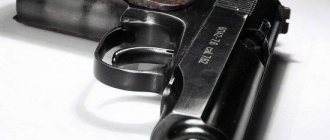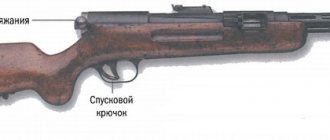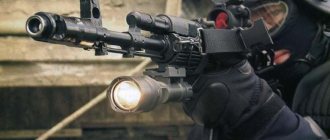No matter how they call the assassination of the 35th US President John F. Kennedy - both the biggest mystery of the 20th century and a conspiracy of the CIA and the FBI; There are dozens of different versions of who exactly shot in Dallas. There is still no final opinion about the identity of the killer.
But the chronicle of the crime is known literally minute by minute. Not only do we know exactly what happened in Dallas on November 22, 1963, but we can see it. Businessman Abraham Zapruder decided to film the passage of the presidential motorcade with a film camera, and ended up filming the murder. So the attempt was documented, and the film was immediately handed over to the special services. We will restore the picture too.
Jacqueline Kennedy and one of the president's guards immediately after the shot. Source: gazeta.ru
Nagant, model 1895
This revolver was designed by the Belgian Leon Nagant in 1894. However, first of all, “Nagan” is associated with the Russian, and then with the Red Army, since Russia bought the rights to its production. The revolver is designed in such a way that it practically eliminates the breakthrough of powder gases, which is characteristic of other revolvers. This mechanism requires specially designed cartridges to operate properly. The Nagan had a one-piece frame; cartridges were inserted into the drum one at a time through a door on the right side of the frame. They produced two versions of this revolver with single or double action trigger mechanisms.
TT, model 1930
The pistol was designed by Fedor Tokarev, who also developed other weapons for the Red Army, including the SVT-38 automatic rifle and the MT1925 pistol. The design was apparently based on the Colt M1911 Browning system, although with some changes made for ease of production and repair (for example, the TT had a trigger mechanism mounted in one block). The pistol is chambered for a 7.62 mm caliber cartridge, similar to the 7.63 mm Mauser cartridge. This pistol was completely superseded by a modified version designated "TT Model 1933".
"Papa"
At the front, many types of weapons and military equipment were given affectionate nicknames by soldiers that were consistent with their markings. Thus, the 76-mm ZiS-3 divisional gun was nicknamed “Zoseya”, the 152-mm ML-20 howitzer gun was called “Emelei”, and the Tokarev self-loading rifle “SVT-38/40” was called “Svetka”. The soldiers nicknamed the PPSh-41 submachine gun “Daddy.”
Shpagin's weapon at the front was simply irreplaceable for scattering chains of advancing infantry, when storming enemy fortifications and trenches, and in battles in the city. Until some time, the PPSh-41 was the standard weapon of tank crews and armored car crews.
PM (Makarov pistol)
This pistol was designed in the late 1940s. Nikolai Fedorovich Makarov, became a service weapon in the Soviet armed forces, replacing the TT pistol. The blowback pistol is chambered for a new 9 mm caliber cartridge, developed specifically for it and not interchangeable with a NATO cartridge of the same caliber. Double action trigger mechanism, free firing pin. The design of the pistol is very simple, it consists of seven main parts. When firing by self-cocking, a long and strong press on the trigger is required, subsequent shots are fired with less force on the trigger.
From PPD to PPSh
The production of PPD-40, the forerunner of the PPSh, was a temporary solution to replace the PPD-34/38. Their production required high-precision measuring and production instruments, precision milling machines and technical specialists. The PPD-40 design had 95 parts. It took more than 15 man-hours to produce one copy.
Georgy Shpagin participated in the 1940 competition to develop a new submachine gun to replace the PPD-40. His sample turned out to be very technologically advanced in production and showed excellent ballistic characteristics. For the production of PPSh-41, cold stamping and spot welding were used for the first time in the weapons world; the weapon consisted of 87 parts and two threaded connections. The cost was 500 rubles per piece, and production required just over 7 man-hours.
© From the Victory Museum fund
PPSh-41 at the top of the first series mod. 1941, below the second modified series of 1942.
Already during the war, Shpagin improved weapons, where the number of parts decreased, but the characteristics and reliability remained at a high level. Manufacturing time was reduced to 5 and a half man-hours, and the cost in 1945 was 132 rubles.
Baikal-442
This is a modified version of the PMM pistol, designed for the export market, which can be loaded with both Russian 9mm Makarov and 9mm Luger cartridges. Magazines with a capacity of 8, 10 or 12 rounds. Like the PMM, the Baikal is a blowback pistol.
In the Russian city of Izhevsk there are two large weapons factories and IzhMekh. IzhMash was founded in 1807, and IzhMech appeared as an independent enterprise in 1942. IzhMech produces Makarov and Stechkin pistols. He is the owner of the Baikal trademark.
Production
Mass production of the PPSh-41 began only in May 1941, literally a month before the start of the Great Patriotic War. It was decided to establish production at a new, essentially under construction, Zagorsk hardware factory, which received this name for secrecy purposes. Shpagin was transferred to work there.
By the beginning of the war, there were few PPSh-41s in the army. The plant began operating at full capacity in July 1941, producing thousands of weapons per day. As the front approached, production was evacuated to the workers' village of Vyatskie Polyany.
The simple production technology of PPSh-41 made it possible to launch its production in unprepared production areas, by not the most qualified specialists. In 1941, enterprises in Zagorsk, Moscow, Izhevsk, Alma-Ata, Tomsk, Vladivostok and other cities produced 90 thousand units. And already in 1942, 2.5 million of them were sent to the front.
© From the Victory Museum fund
Fragment of the exhibition Feat of the People - arms factory producing PPSh-1.
APS
This pistol was developed by Igor Stechkin in Tula after World War II, when the need arose for powerful automatic weapons. Production began in 1951. This blowback pistol can fire both single shots and bursts. It was accompanied by a wooden or plastic holster, which also served as an attached butt. Since this weapon was intermediate between the pistol itself and the submachine gun, it is currently not in service with the Russian army.
What's inside?
The operating principle of the PPSh-41 submachine gun is based on the use of blowback recoil. In addition to automatic firing, it is possible to conduct single fire. The fire mode translator is located inside the bracket in front of the trigger. The design of the fuse is identical to that of the PPD-40 and is made according to the principle of a slider located on the bolt cocking handle. It can block its operation in the forward or rear position.
Like the Degtyarev submachine gun, the Shpagin's receiver and barrel casing are one part, which is attached to a wooden stock made of birch. Sighting devices were located on the receiver in the form of a sector sight with a gradation of firing from 50 to 500 meters.
Only the barrel required fine and precise machining in the manufacture of the PPSh-41. The bolt was made on a lathe with rough milling. Most other metal parts were made by stamping.
One of the design features of the Shpagin submachine gun barrel casing is an integrated muzzle brake-compensator, which protruded beyond the muzzle of the barrel and was an angled plate with through windows. When conducting automatic fire, the muzzle brake-compensator, due to the action of powder gases during a shot, significantly dampened the recoil, which increased the accuracy and accuracy of fire. For ammunition supply, the PPSh-41 was equipped with a drum-type disk magazine with 71 rounds.
MC (Margolin pistol)
The MC (Margolin Target) sports pistol was developed by the blind Russian designer Mikhail Margolin. This blowback pistol with windage and windage adjustable sights has been in use since the 1950s. The MC is quite easy to handle due to its light weight and thin barrel, although the recoil may be greater than expected.
"Symbol of Victory"
During the Great Patriotic War, almost 6 million Shpagin submachine guns were produced. This is the most popular weapon of this class not only in the USSR, but also among other countries participating in the war. PPSh-41 went through the entire war and took part in all the key battles. Mikhail Egorov and Meliton Kantaria with PPSh-41 at the ready in May 1945 hoisted the Victory Banner over the Reichstag in Berlin.
The weapon created by Georgy Shpagin, along with the T-34 and IS-2 tanks, La-7 and Il-2 aircraft, became a real symbol of Victory.
PPShs were in service with the Soviet Army until the mid-1960s, until they were replaced by Mikhail Kalashnikov’s assault rifle. Shpagin's brainchild was manufactured in dozens of countries in Europe, Asia and Africa and is still in service in some places.
© From the Victory Museum fund
Fragment of the exhibition Feat of the People - arms factory producing PPSh-1_From the collection of the Victory Museum.
PSM
This pistol became the service weapon of the USSR police and security forces in the 1970s. It is designed for the new 5.45 mm caliber cartridge. The pistol is flat and compact, making it easy to carry concealed. The shutter is free, double-action trigger mechanism. The 5.45 mm bullet does not have a very powerful stopping effect, but has high penetrating ability. The safety latch is located at the rear of the bolt.
Artifacts of the Victory Museum
The exhibition and collections of the Victory Museum feature 17 PPSh-41 submachine guns manufactured in 1941–1945, including a rare experimental curved-barreled PPSh. In the “Feat of the People” section there is an exhibition stylized as a factory workshop, dedicated to the production of small arms during the war by women and children, who replaced the men who went to the front at the machines. Visitors to the Victory Museum can try to assemble a front-line weapon - the famous PPSh-41 submachine gun - manually or using modern multimedia touchscreen screens.
MP-443 "Rook"
This is a self-loading pistol with a barrel locking according to the Browning system and high penetration ability. The bullet fired from it is said to penetrate many types of body armor at a distance of 50 m and a steel plate at a distance of 30 m. The Army designation 6P35 was assigned to all pistols that took part in the competition for the new army pistol, which was held in the 1990s. This pistol, known under the designations 6P35 or MP-443 "Grach", is currently officially adopted by the Russian army and law enforcement organizations.
Work on mistakes
During military operation, changes were made to the design. The disk magazine, originally borrowed structurally from the Finnish Suomi-M31, turned out to be not the most reliable structural element.
The magazine was first converted for the PPD-40, after which it was inherited by the PPSh-41. Its production remained difficult, but justified, based on the capacity of 71 rounds.
© From the Victory Museum fund
A Red Army soldier with a PPSh-41 in battles near Moscow.
For each sample, two or three disk magazines were made. It happened that the magazine from one PPSh did not fit another. In this regard, on February 17, 1942, a new box magazine with 35 rounds was accepted for production. Manufacturing technology has been improved and quality control has been strengthened. But in wartime conditions this was difficult to do. Until the end of the war, both types of magazines were used in the army.
The design of the sight has changed. A reversible rear sight appeared with a gradation of “10” and “20”, which meant 100 and 200 meters, and not “from 50 to 500”, as was previously the case on the sector sight.
Another disadvantage of the PPSh-41 was its weight. The loaded submachine gun weighed almost 5 kg. The designer wanted to change this parameter when creating PPSh-42 or PPSh-2. However, at the competition at the end of 1942, where Shpagin presented his sample, Alexei Sudayev’s PPS-43 won in the final. The more compact and lighter PPS-43 was received by military personnel of armored, reconnaissance and sabotage, and airborne units.
Several variants and modifications of the PPSh-41 have been developed. For example, “PPSh-Bramit”, designed for silent shooting. It was assumed that specialized units would be armed with such silent weapons for operations behind enemy lines.
© mycity-military.com
Experimental version of PPSh-Bramit.
Another experimental model created by Kovrov gunsmiths in 1945 on the basis of Shpagin’s weapons was a curved-barreled submachine gun. The barrel bore and weapon casing were bent by 30 degrees. This option was developed for armored vehicle crews, as a weapon of last chance, if there is a high risk of the combat vehicle and crew being captured, as well as for shooting from a trench. However, this version was also rejected by the military.
We also considered the use of PPSh-41 in aviation. In mid-1944, the firepower of the PPSh was expected to be used to storm enemy infantry columns on the march or during battle. For this purpose, a special platform structure was designed, which was located in the bomb bay of the Tu-2Sh bomber. 88 PPSh-41 submachine guns were mounted on it. This entire structure was named “PPSh Battery”. It was assumed that during the attack the pilot opened the bomb bay and, using a special sight, opened fire on the enemy.
© From the Victory Museum fund
PPSh-41 in the bomb bay of a Tu-2Sh bomber.
Only by the beginning of February 1946 did the PPSh Battery undergo flight tests. Despite the fact that it showed great efficiency, firing due to the high rate of fire of the weapon was short-lived, and it was impossible to change the ammunition supply of the PPSh except from standard disc magazines with 71 rounds. As a result, it was decided to use small-caliber cluster bombs to destroy enemy personnel.
© From the Victory Museum fund
Decorated with stickers, the PPSh is a trophy of the Soviet Army from Afghanistan in the 1980s and the experimental curved-barreled PPSh-41.
Revolver Strike
This revolver was developed as a special weapon for the police and special forces. It is a defensive weapon and is designed to perform a wide variety of tasks in crowded areas. Various types of ammunition are available for the revolver, some of which are very different from conventional cartridges. Thus, there are 12.3 mm cartridges with plastic bullets, with marking bullets, as well as noise blank cartridges. This set allows the use of certain deterrents depending on the degree of danger. This revolver is unlikely to cause serious physical harm.










